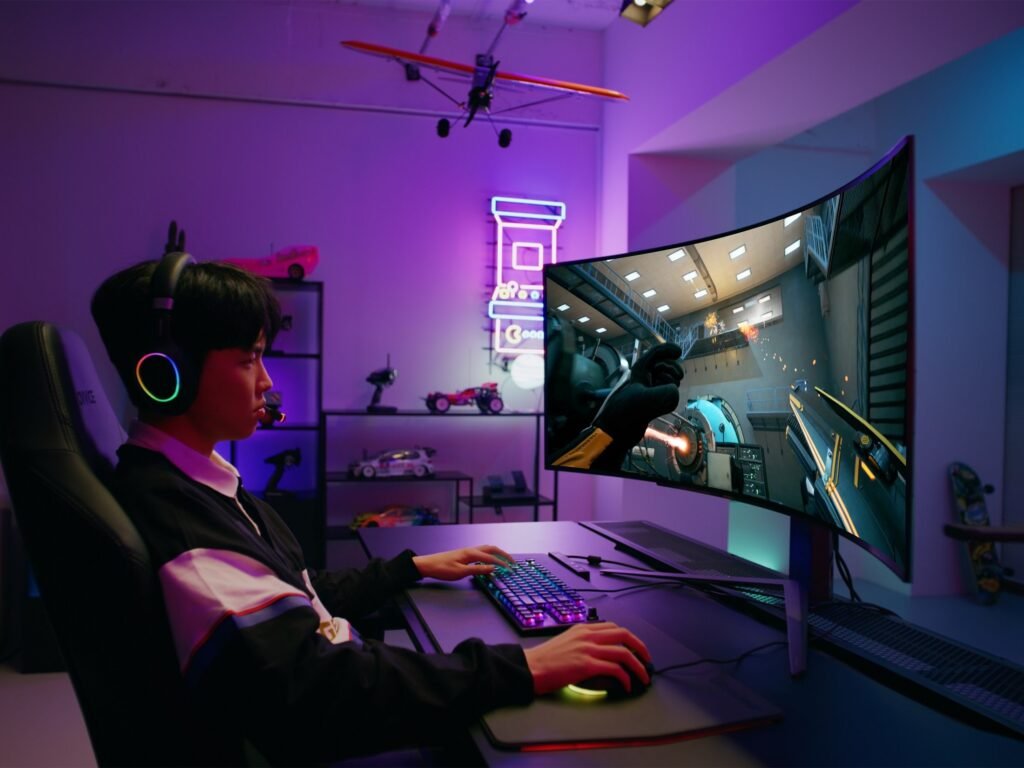One of the top ways to enhance your PC is by Purchasing an OLED Gaming Monitor .

Are you hesitating to purchase an OLED monitor? As someone who has been using one as my primary PC display since 2022 Purchasing an OLED Gaming Monitor should be a priority, I can definitively say that switching back to an LCD is now out of the question. Allow me to convince you why investing in one would be a worthwhile decision.
Picture quality that cannot be matched
When you switch to an OLED monitor from a standard LCD monitor, the most apparent change is in the picture quality. This becomes evident right away.
When a dark scene is displayed on OLED displays, the ability to independently turn off each pixel leads to authentic black levels. This feature contributes significantly towards achieving an infinite contrast ratio that enhances viewing experience.
In contrast, LCD displays keep their backlight active even when displaying completely black content. The example image showcases this difference clearly – the left monitor’s illuminating background indicates it employs an LCD panel.
Moreover, it is worth mentioning that the monitor located on the left boasts a 4K resolution while its counterpart -an OLED monitor positioned to the right- offers only up to 1440p. Despite having less pixels, I still favor watching videos using the latter due to its unequaled picture clarity at every viewing angle.
An impressive feature of this monitor is that the colors do not fade when viewed from different angles; its picture quality remains constant. For those who prioritize a broad visual spectrum, it would be wise to invest in an OLED TV or monitor since no other display compares to their viewing capacity.
Experience true HDR
Numerous LCD monitors currently available in the market claim to support HDR, but their peak brightness levels hover around 600 nits. In such a scenario, can these monitors genuinely accommodate HDR content?
When viewing HDR content, Purchasing an OLED Gaming Monitor OLED monitors can reach brightness levels of up to 1,000 nits despite their peak SDR performance falling short of that offered by LCD monitors. The reason for this is the ability of individual pixels to switch off on an OLED display – resulting in a significant advantage within a limited window (i.e., when just 10 percent displays white and the remainder black).
While OLED monitors may not be able to match the HDR brightness levels of mini-LED displays or VA monitors, which can surpass 1,000 nits in some cases, it is important to consider their superior black levels and infinite contrast ratio. These qualities give OLED monitors an advantage over its competitors as they provide a more visually immersive experience especially when used in dark environments.
Rapid Gaming Response Time
Gamers can enhance their experience with a high refresh rate OLED monitor instead of most LCD gaming monitors. This is because an OLED display offers nearly instantaneous pixel response time of only 0.03ms, which beats the fastest TN LCD monitors that claim to have a response time of 0.5ms. However, how does this translate into practical usage?
OLED monitors are ideal for fast-motion scenes, as they do not create any trailing effects on moving objects. Consequently, viewers can avoid the bothersome problem of “monitor ghosting” that affects almost all LCD displays and persists even with higher refresh rates.
In essence, if a monitor has lower response time, there will be less ghosting. Nevertheless, gaming monitors usually have 1ms to 3ms of response time that cannot compete with OLED displays.
In order to reduce response time and eliminate ghosting, a number of gaming monitors come equipped with pixel overdrive functionality. Nevertheless, this can introduce yet another problem called inverse ghosting whereby pixels alter color too rapidly and overshoot their intended target colors resulting in ghost images appearing on the screen. With an OLED display, none of these issues will be encountered.
Burn-in warranty is included in the majority of OLED monitors
OLED displays are notorious for suffering from screen burn-in, which has become one of their major drawbacks. This is perhaps why many people have reservations about purchasing an OLED TV or monitor. Although it’s inevitable to encounter this issue in the long run, I’m yet to experience any image retention on my OLED monitor despite daily usage since 2022.
If you continuously exhibit a fixed image on your OLED monitor for extended periods every day, there’s a possibility of experiencing image retention over time. However, contemporary OLED monitors mostly come with features designed to maintain the quality of their panels such as pixel refresh, pixel shift and panel refresh. If these functions are utilized routinely, screen burn-in risks can be significantly reduced or even completely avoided.
We want to reassure you that the majority of OLED monitors come with a warranty lasting either two or three years, providing protection against screen burn-in. For instance, Dell and MSI offer a generous three-year coverage for their OLED displays whereas Asus provides a two-year burn-in warranty. Nonetheless, we advise verifying the specific terms and conditions present on each monitor’s specifications page carefully.
You might be surprised to find that OLED monitors are more affordable than you assume
Despite the multitude of benefits they offer, OLED monitors may be mistakenly assumed to come with a hefty price tag. While indeed pricey in 2022 when the technology was nascent in monitors, today’s digital landscape offers several options for less than $1,000.
The MSI MPG 321URX is the company’s top-of-the-line QD-OLED monitor with a resolution of 4K and refresh rate of 240Hz, priced at $950. Meanwhile, Amazon offers previous year models such as Asus ROG Swift PG27AQDM and LG27GS95QE for less than $900.
You may have assumed that OLED monitors come with a hefty price tag, but in reality they only cost slightly more than top-of-the-line LCD gaming monitors. Don’t let budget concerns hold you back from upgrading to an exceptional display today!

